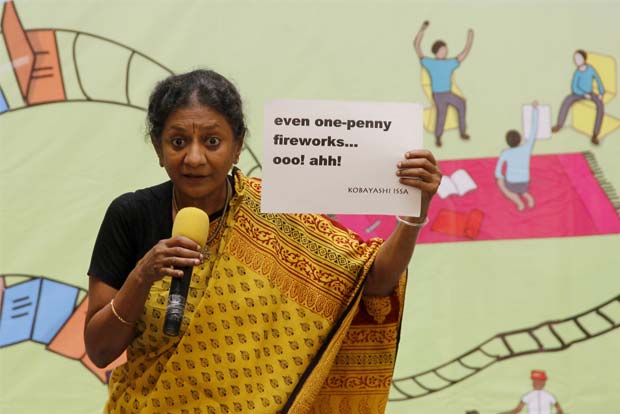Begin typing your search...
Haiku, where silences speak louder than words
Playful, full of life and provocative. Kala Ramesh is just like the haiku she writes.

Chennai
On a recent visit to her hometown, Chennai, Kala, a pioneer in this Japanese form of poetry in India, speaks about marrying the cultures of Japan and India in her works, finding home away from home in the hills of Pune, and her latest book Beyond the Horizon Beyond.
A poet and editor, Kala Ramesh writes and teaches haiku to children, undergraduates and senior citizens. For the uninitiated, haiku is a three-line Japanese form of poetry with seventeen syllables, written in a 5/7/5 syllable count. Often centred on images from nature, haiku emphasises simplicity, intensity, and directness of expression.
Haiku was traditionally written in the present tense and focused on associations between images. However, over the years, many of these rules — including the 5/7/5 practice — have been routinely broken.
Having mastered the art, Kala is an external faculty member of the Symbiosis International University Pune since 2012, where she teaches haiku to undergrads — a first in the country. Speaking about haiku caught the fancy of an Indian classical vocalist like her, she says, “I wasn’t really much of a writer apart from the leave of absence letters I wrote for my children. It was only in January 2005 that I stumbled upon this haiku website boloji.com.
I downloaded it on a whim and I fell in love with not only haiku but also its allied forms like tanka and haibun, instantly,” begins Chennai-born Kala.
Passionate about taking haiku to everyday spaces, Kala initiated the ‘HaikuWALL India’ project, which has graffiti artists paint haiku on city walls.
Starting in 2006, she has organised five haiku festivals in India so far. Her latest project is her book Beyond the Horizon Beyond, a collection of haiku and haibun, containing 11 years of her work. This book is all about the 283 haiku in five elements known as the Panchabhuta,
and 41 haibun (haiku embedded prose). We can’t help but ask her about the intriguing title Beyond the Horizon Beyond. “You don’t end up at a wall when you reach the horizon. Beyond every horizon is another. That’s how haiku is. The end of every poem is the beginning of another,” muses Kala whose book was
launched as part of the Poetry with Prakriti monthly series. Speaking about how haiku syncs with the Indian psyche, she says, “There are quite a few similarities. The 5/7/5 syllable count in haiku is much like rhythmic patterns like kanda nadai or misra nadai in Indian classical music and dance for hundreds of years. Our dvaita concept of oneness with the universe is an integral part of haiku too.”
How does she compare haiku with Indian verse formats like Dohe (Hindi couplets) or Thirukkural? “Thirukkural and Dohe are lovely. But they’re very heavy, preachy and complicated.
Haiku, on the other hand, is simple, and lets the reader form his or her own opinion and perspective. There are a lot of silences in haiku that give one the space to think and weave their own narrative. These silences speak louder than words. It is called a wordless poem not only because it includes just 9 to 10 words, but also because it’s bare without adjectives and poetics.
But the format of haiku also poses its biggest challenge of retaining the reader’s attention within the short span,” she describes.
She adds, “The true essence of haiku is to focus on a brief moment in time; a use of provocative, colourful images; an ability to be read in one breath; and a sense of sudden enlightenment and illumination.”
For Kala, who has been living in Pune for 23 years now, a visit to her hometown is always special. “Having grown up here, I miss waking up to the sounds of bhajans in the morning and being greeted with kolams on streets. But what I miss the most is the sights and sounds of the Marina. I try to compensate that by trekking in the hills of Pune. However, it’s never the same,” she finishes.
Visit news.dtnext.in to explore our interactive epaper!
Download the DT Next app for more exciting features!
Click here for iOS
Click here for Android
Next Story



